Customer Interview Frameworks
“It isn’t the customer’s job to know what they want.” - Steve Jobs
A couple months ago I wrote about the Problem Space and the Solution Space. The main idea of the article, if you haven’t read it, is that product managers should be spending an unbalanced amount of time in the problem space. You are the one in the organization who has the opportunity to do so and you owe it to your team to do it well.
What does this have to do with customer interviews?
Knowing what your customer needs is squarely in the problem space. To wholly understand the problem space you must know your customers needs better than they know them.
But knowing your customers needs more than they do is impossible if you never talk to them.
Enter: customer interviews…
What are customer interviews?
Talking to your customers on a regular basis and calling it a customer interview is not enough. These conversations may help you come up with new ideas for the product and make your customers feel heard, but they aren’t customer interviews. Talking to your customer without a clear goal is not a customer interview.
Customer interviews are a structured conversation with a specific goal in mind to help further the product vision and mission.
You will want your customer to be ready for the interview and know what you intend to talk about. Don’t blindside your customer, let them know you are wanting insights about your product and will come prepared to lead the conversation.
You are likely to learn a lot of different things while doing customer interviews. These include customer frustrations with their current workflow, new feature suggestions they want you to add to the product, and complaining about how your team doesn’t get bugs squashed fast enough. All these things are great feedback to use when deciding what you should be working on next. However, not all the information is created equal.
How to interview a customer
There are dozens. of. articles. out. there. about. the. top. questions. to. ask. during. customer. interviews. This is not one of them.
You can have an amazing list of questions planned out and afterwards feel really good about your interview yet still accomplish nothing. You need a specific goal to accomplish in your interview to make it worth your while.
Go into every customer interview with a specific goal in mind and use the right type of interview framework to accomplish that goal. Don’t let the customer take you down rabbit holes you don’t want to travel. Help keep them on track by choosing a framework that suites the goals you have set out for the interview.
The important thing to remember when performing customer interviews is: don’t reinvent the wheel. There are too many resources and frameworks out there to utilize. Find one that fits your needs and run with it.
Customer Interview Frameworks
Each of these frameworks illicit different types of feedback and accomplish different goals. You will want to pick which to use based on your relationship with the customer and what stage your product is in.
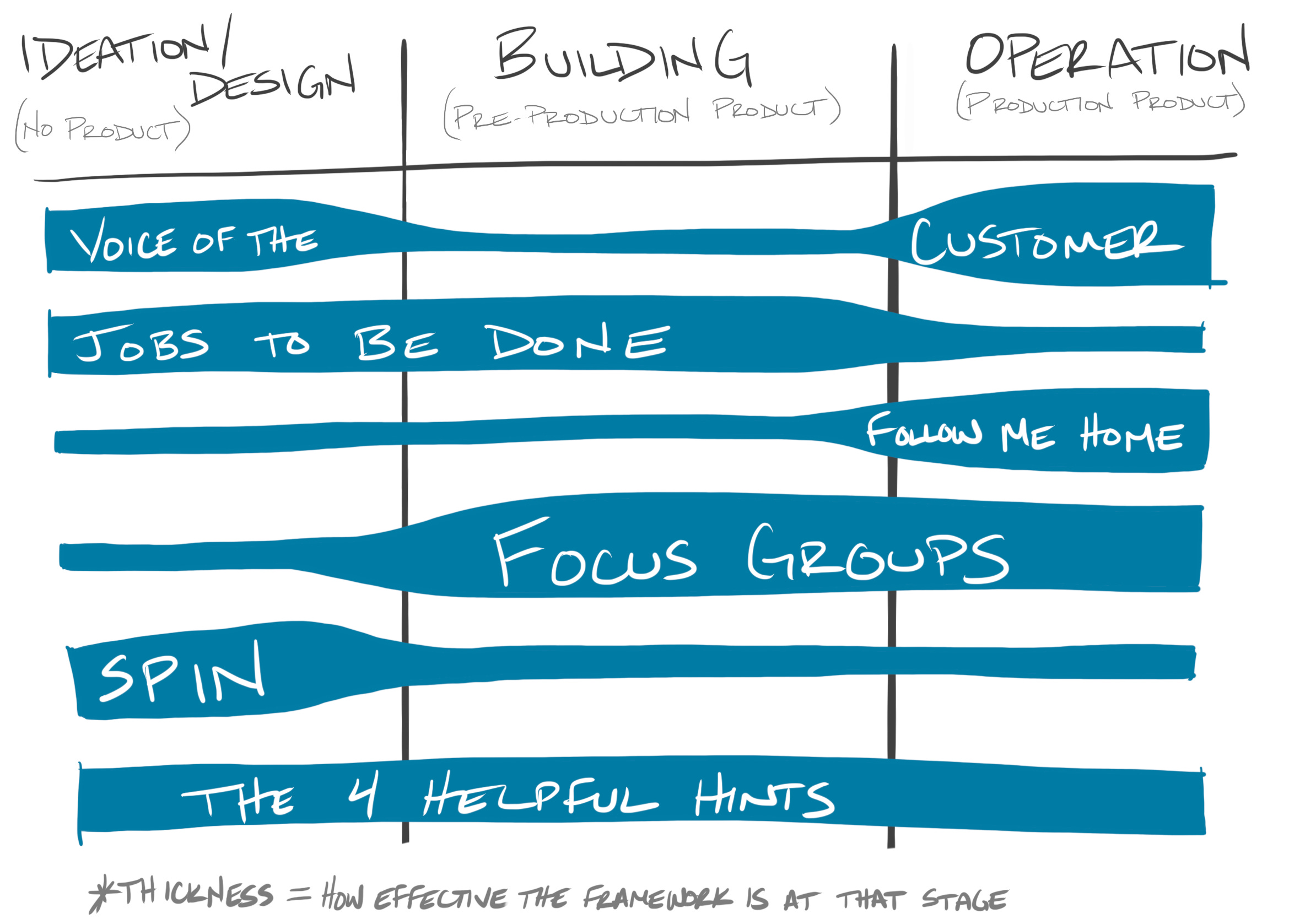
All products follow a basic pattern of “ideation/design” to “building” to “operation”.
Ideation/Design is the phase before you have a product. You are likely building requirements, testing the market, and trying to figure out what to build.
Building follows ideation/design and includes all the time you spend working on the product until you launch it into production. I would consider any products that are in a limited “beta” release part of this stage.
Operation is when you have a product in production being used and depended upon by customers. This comes with its own challenges and needs that even products in public beta don’t experience.
You should be talking to your customers during each of these phases, but your goals and informational needs will differ between them. While you can use any of these interviewing techniques and get some value from the interview, you shouldn’t settle for “some value”. Choose the framework that will get you the most value possible.
1. Voice of the Customer
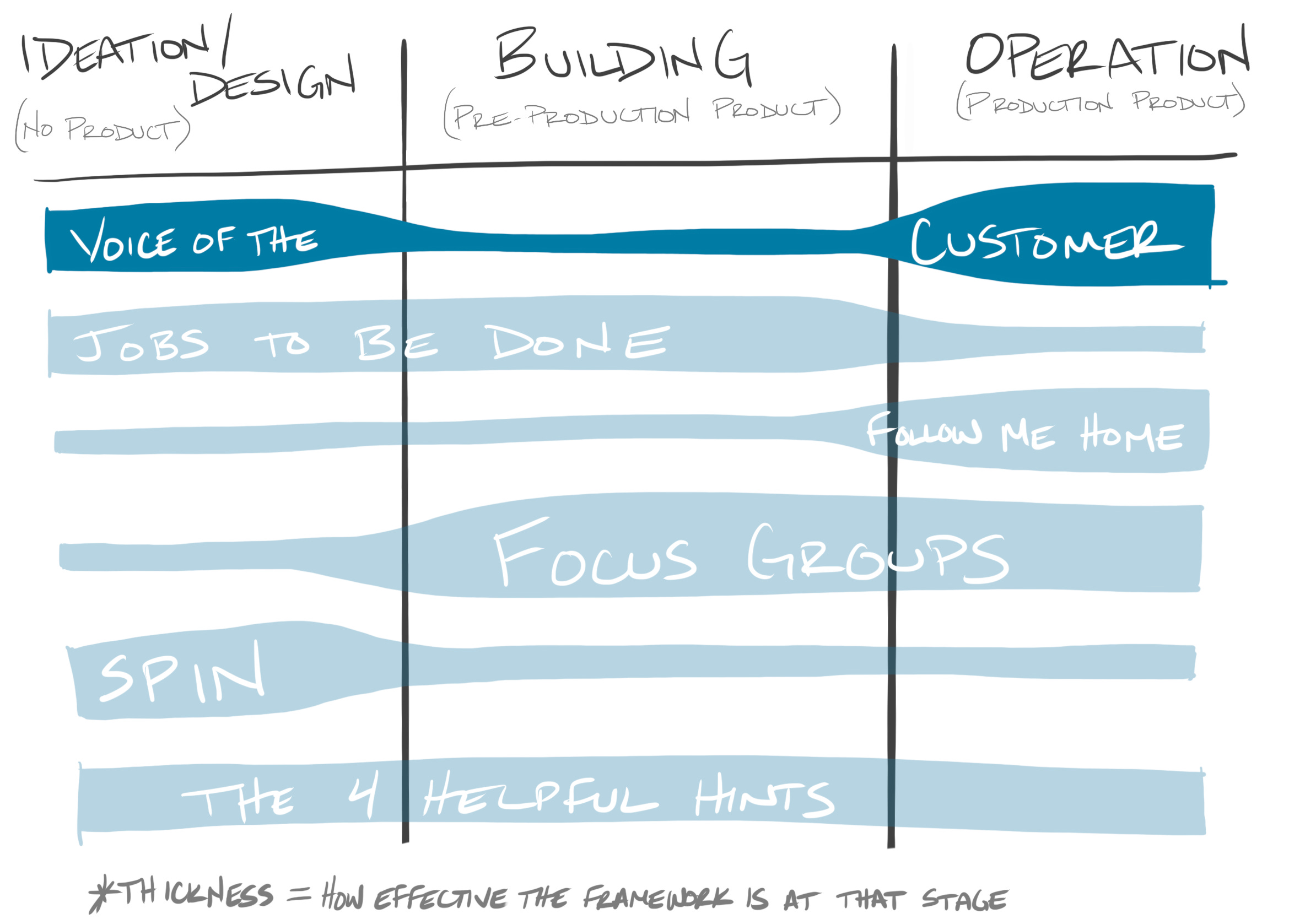
Optimum Phases: Ideation/Design, Operation
Goal: Create a prioritized list of customer wants and needs.
VoC Overview
Voice of the Customer can be a specific interviewing type and a goal in one. Listening and collecting the voice of the customer will make your product better in nearly every metric you measure.
Searching for the Voice of the Customer results in a detailed list of the customer wants and needs. Use this as an opportunity to look at your product from the eyes of another. They will highlight things you don’t see.
You should leave this interview with 4 things:
-
A complete set of customer wants and needs
-
In the customers own words
-
Organized in a structural hierarchy by the customer
-
And prioritized by the customer by relative importance
VoC Resources
VoC Shortcomings
Don’t let customer ideas be your only source for innovation. It is their job to tell you the challenges they have, it is your job to find an innovative solution. Sometimes customers will have innovative product ideas, but most of the time these are short-sighted and over-optimized for one type of user… them.
2. Jobs to be Done
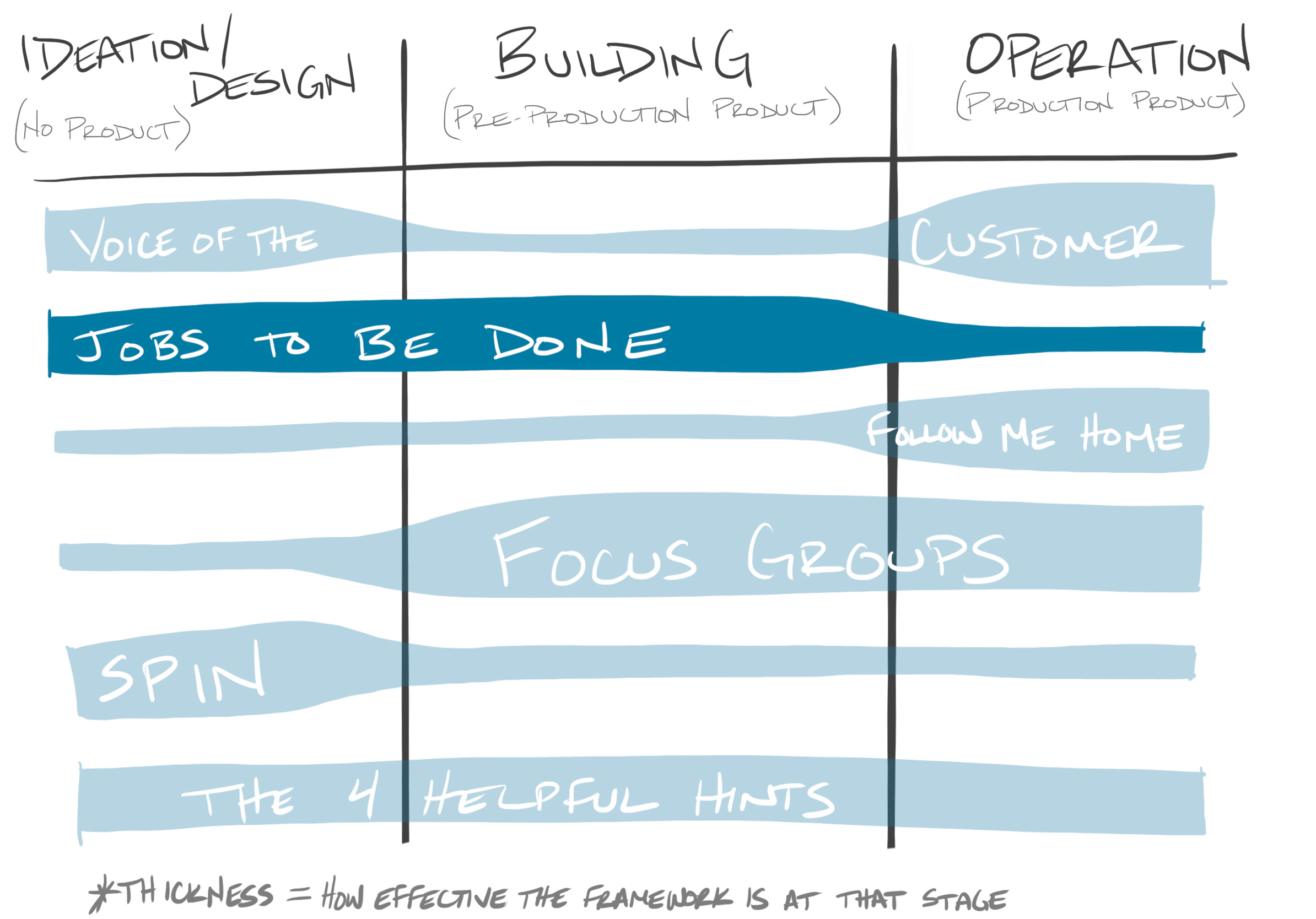
Optimum Phases: Ideation/Design, Building
Goal : Create a job statement to align why customers hire your product.
JTBD Overview
The Jobs to be Done framework was popularized by Clay Christensen. The idea is that people “hire” products to complete a “job” for them. The best way to ingest this idea is to watch Clay himself explaining why morning commuters hire a milkshake.
When using the JTBD framework to interview, you don’t want to focus on buying process, criteria, or anything else that distracts from the actual job needing completing. Your only goal is to gain a deep understanding of the job the customer is trying to get done.
A good job framework must:
-
be stable, changing infrequently
-
have no geographical boundaries
-
is agnostic of the solution itself
-
be a process
JTBD Resources
JTBD Shortcomings
The JTBD framework can be too abstract. This can lead to your customer not articulating their job accurately and you getting misleading information. Make sure to ground the conversation in reality and always ask for examples.
3. Follow me Home
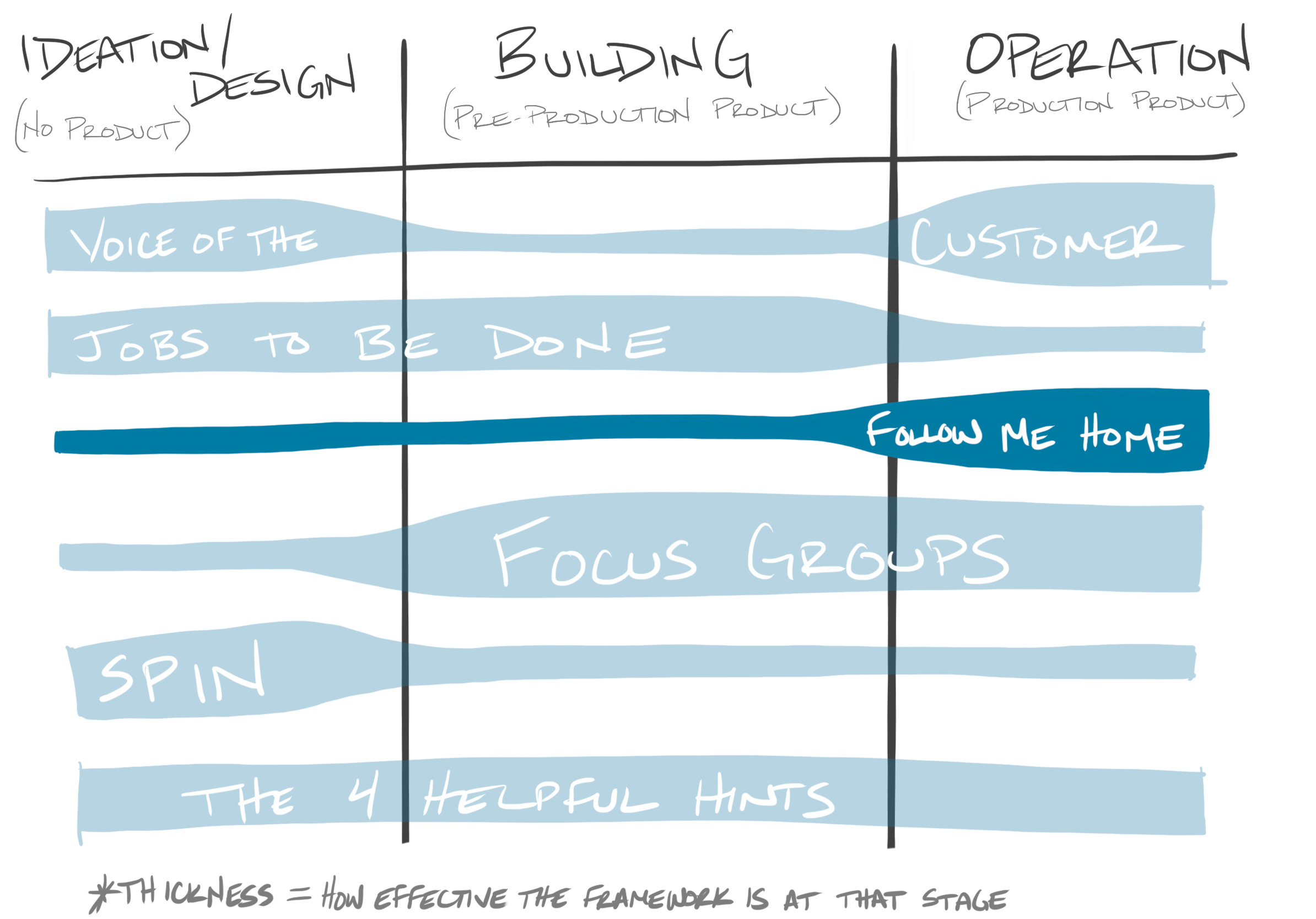
Optimum Phases: Operation
Goal: Understand how the user interacts with your product in their natural habitat.
FMH Overview
The Follow-Me-Home framework has been popularized by Intuit CFO, Neil Williams. Neil suggests the best way to get information about how your user interacts with your product is to meet them where they typically use it. This means getting out of your office, driving (or flying) to where your user is, and watching them complete their daily work. You learn things about their environment such as how many times they get distracted, who/what else is vying for their time, and when they abandon using your product.
When you allow the customer to interact with your brand and your product in their natural day-to-day work, you learn much more than you could in a simulated interview setting.
FMH Resources
FMH Shortcomings
It can be challenging to meet a customer and not interrupt their flow simply by observing. This is almost like observing wavelengths of light — they act one way when being observed and another when not. You should use this method with customers multiple times so they become comfortable with you watching over their shoulder. Explain to them you don’t want any changes to the way they work so you get accurate information.
4. Focus Groups
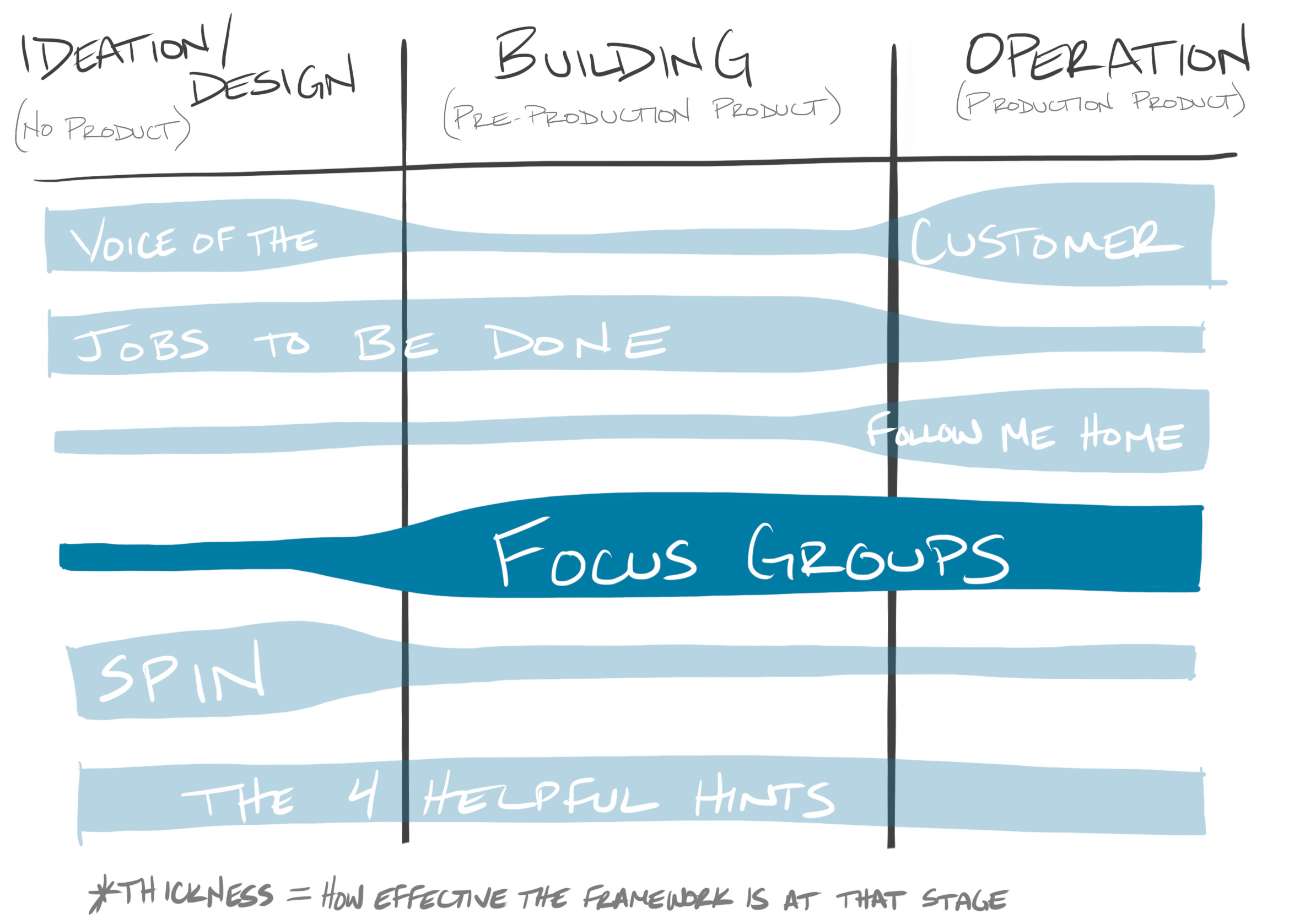
Optimum Phases: Building, Operation
Goal: Collect quantitative data about user preferences.
Focus Groups Overview
Focus groups bring together about 6-12 people to test a product and gather quantitative feedback. These users are aware they are being watched and measured in how they interact with and experience the product. In some cases, users will assign measurements themselves on how much they like/dislike different parts of the product relative to others.
This method works great when A/B testing different mockups and prototypes to determine which route will provide the most benefit for the work required.
Focus Groups Resources
Focus Groups Shortcomings
Focus groups typically require some other type of analysis or interview to have been completed previously. It is hard to perform a focus group without any product or mockup. Users also behave slightly differently and have different preferences when they are out of their normal environment (see Follow Me Home).
5. SPIN
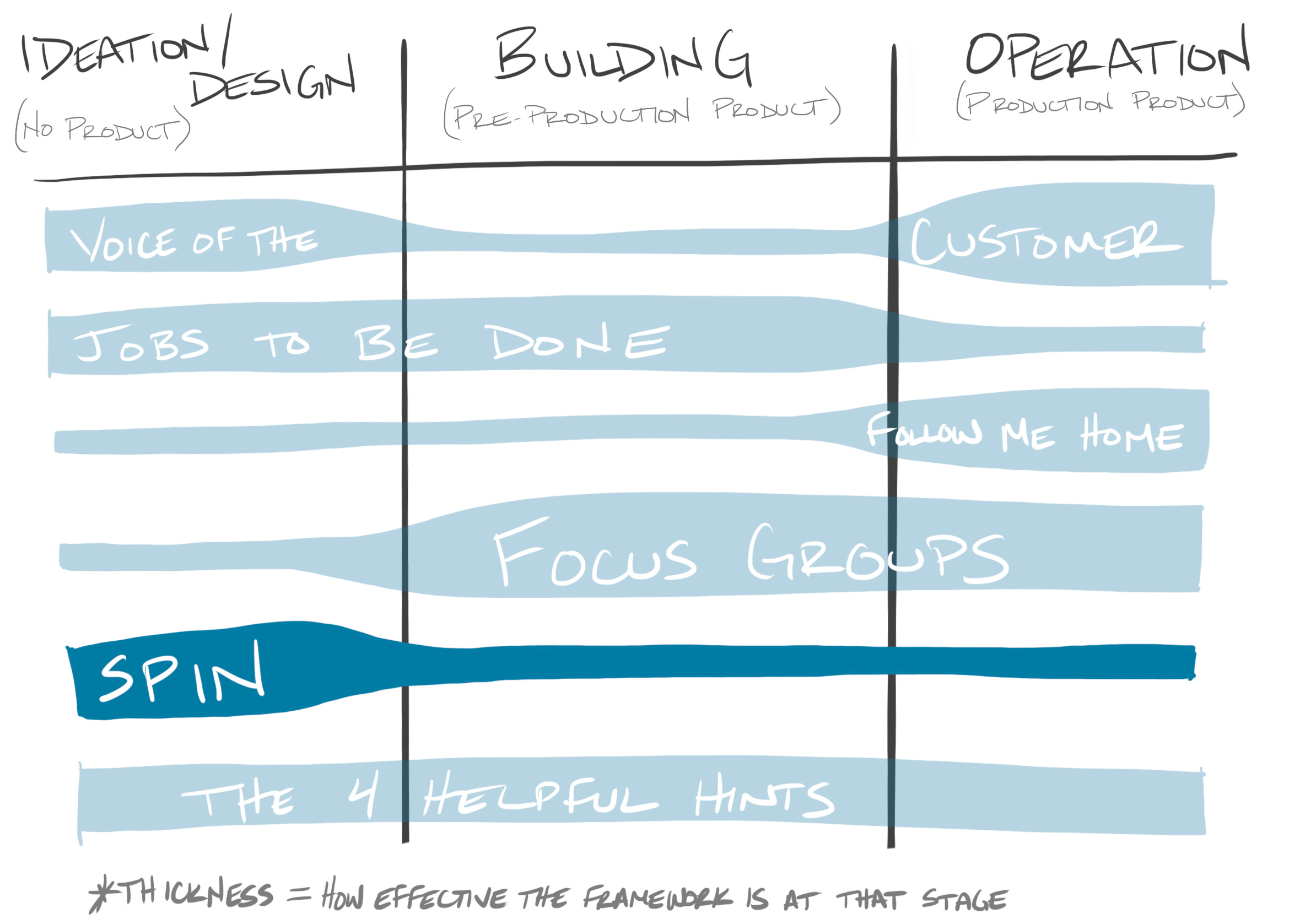
Optimum Phases: Ideation/Design
Goal: Narrow down the problem space to something customers will pay for.
SPIN Overview
Created by Neil Rackman in the 1970s, the SPIN method was initially built for optimizing the sale of an existing product. This framework also works great when interacting with users during the ideation and design phases. SPIN stands for situation, problem, implication, and need-payoff. Each of these steps provide a specific insight.
Situation: You are looking to get background information about the problem space and as much context as possible.
Problem: Explore what makes their job hard. What things do they see could be done better? Ask a user what parts of their job they dread and which parts make them dissatisfied.
Implication: You should find out what the negative consequences are for not fixing the problem. This could include lost time, money, or customer satisfaction.
Need-Payoff: Here you will determine what a customer would be willing to pay to fix the problem. You want to find out what the positive consequences are for solving this problem.
SPIN Resources
SPIN Shortcomings
SPIN is not a fully fleshed out framework for product building and customer interviews. Because of this, there are not many resources on how to conduct these types of interviews and what types of questions to ask at each stage. You will have to get a bit creative and put in the hard work to get this one moving.
6. The Four Helpful Lists
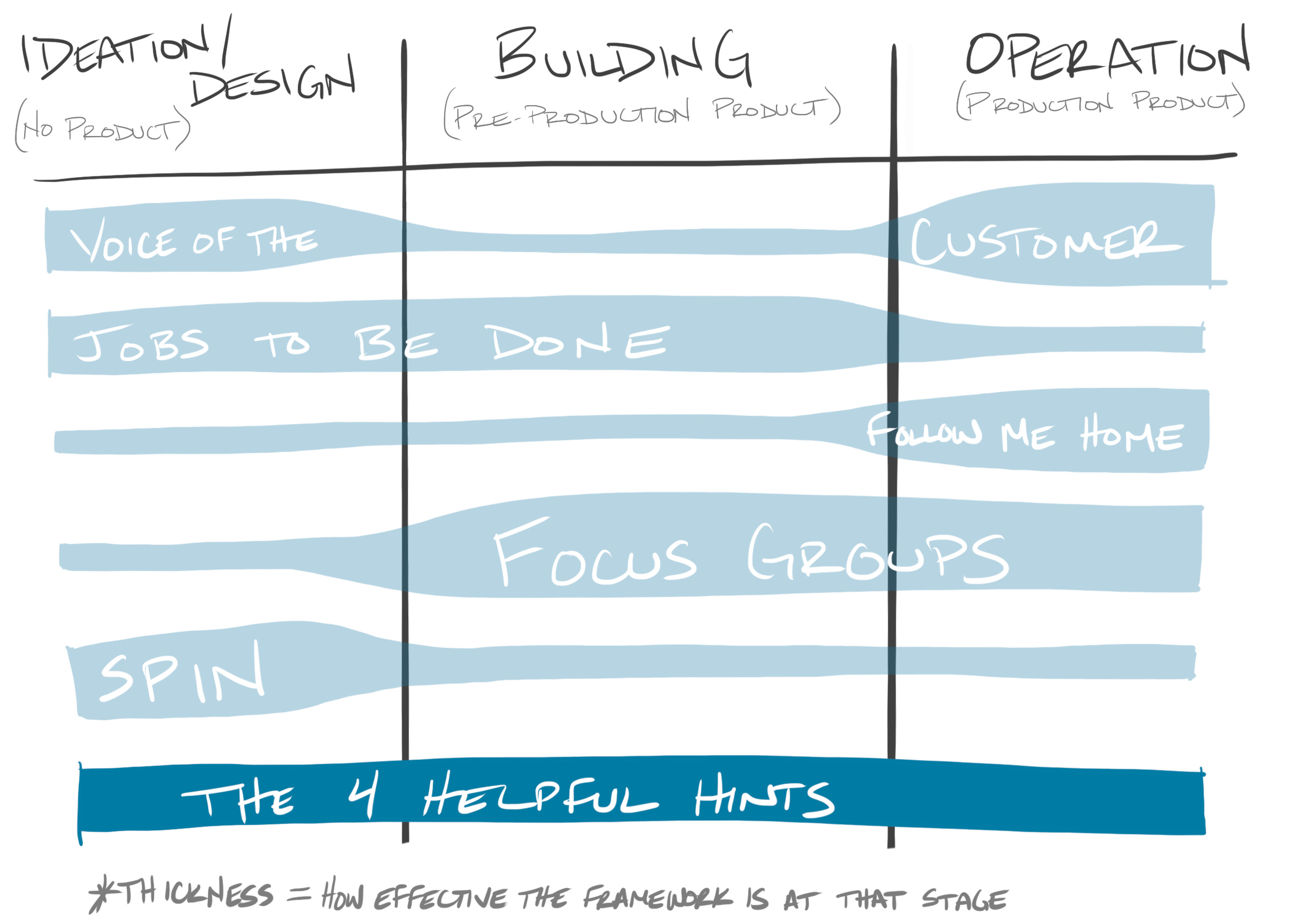
Optimum Phases: Ideation/Design, Building, Operation
Goal: Find product areas on which to focus additional efforts.
4HL Overview
This framework is not only helpful for product interviews, but also for optimizing processes and teams internally. It was created by Tom Paterson and is one of the simplest frameworks on our list.
On a board, create 4 main columns:
-
What’s Right?
-
What’s Wrong?
-
What’s Confused?
-
What’s Missing?
Each of these corresponds to an action you will want to take when building your product: Amplify, Fix, Clarify, and Add (accordingly). Users can add items to each of the four columns in any order and in any quantity. This can be relatively quick or take many hours with a lot of discussion.
This interview tactic is most effective when you are trying to understand what customers like, don’t like, and want changed from their current state. This could be a new customer (not using your product) or it could be a long-time customer (using your product for years). This framework helps narrow down areas of focus across the product lifecycle.
4HL Resources
4HL Shortcomings
This framework is unlikely to get you very specific details about what a user is trying to accomplish and what their jobs are. You will need to follow up this interview with more specific interviews (such as Jobs to be Done) after you have narrowed your focus.
Just talk to your customers
Save this list for the next time you are about to do a customer interview. Identify the goal you are trying to accomplish, and use a framework to help you accomplish that goal.
All of these interview types will provide huge insights for your team and help you build something better than you would have otherwise. The most important thing is to talk to your customers as much as possible and optimize the format to match your goal.
When doing your interviews, remember what your ultimate goal is: live in the problem space and know it better than your customers know it. You should know their problems inside-out and upside-down. Only when you know their problem completely will you start to find the best solutions that even your customers wouldn’t have thought of themselves.
What frameworks are missing from this list? Add your favorites to the comments below and I will share them out on Twitter!